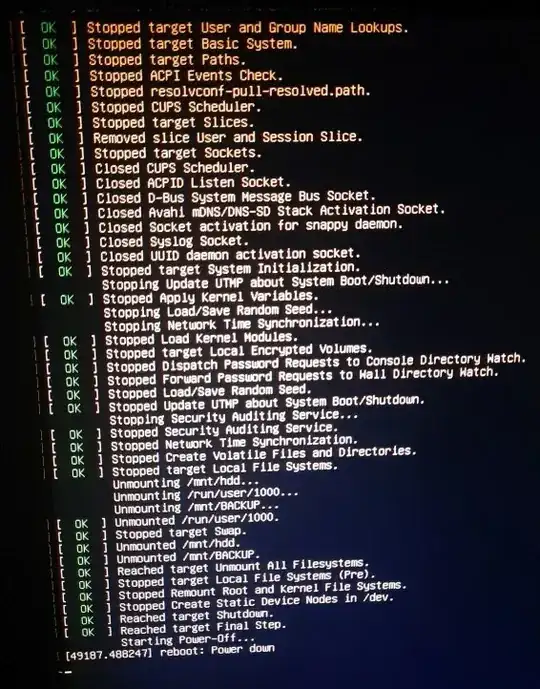My computer suddenly won't shutdown or suspend anymore. Disks power down, but the computer won't. I have to shut down the computer by holding the power button.
The shutdown process ends with a "reboot: Power down" message, but nothing happens:
And it just stays like that. It used to work fine. The only thing I remember doing is running BootRepair a few days before because an update messed up booting. But I believe I may have shut down with no issues at some point after that.
Rebooting shows a similar message ("reboot: Restarting system") but after around 15 seconds, it does eventually reboot.
Things I have tried but made no difference:
- Booting with previous kernels
- Shutting down with
sudo shutdown -P -h now,systemctl poweroff,sudo poweroff - Resetting BIOS (by removing the CR2032 battery)
- Adding
acpi=force,acpi=off,acpi=on,reboot=pci,reboot=bios,reboot=acpito kernel params - Disabling USB 3.0 legacy mode in BIOS settings
I'm running:
- Ubuntu MATE 18.04 with kernel 4.15.0-117
- It's a desktop PC, so no TLP
- Motherboard is ASUS P8H61-M LX3
- Graphics card is ATI Radeon HD 4350/4550
EDIT: dmesg output: https://pastebin.com/gmA0RmEe
Notice the
[ 6.191250] ACPI Warning: SystemIO range 0x0000000000000428-0x000000000000042F conflicts with OpRegion 0x0000000000000400-0x000000000000047F (\PMIO) (20170831/utaddress-247)
[ 6.191254] ACPI Warning: SystemIO range 0x0000000000000428-0x000000000000042F conflicts with OpRegion 0x0000000000000400-0x000000000000047F (\PMIO) (20170831/utaddress-247)
[ 6.191257] ACPI: If an ACPI driver is available for this device, you should use it instead of the native driver

sudo update-grub. Actually, I mostly added the parameters directly in grub boot menu (pressinge). dmesg shows the same errors I posted above. Doesn't mention dw_i2c. https://pastebin.com/gmA0RmEe – gabrielfin Sep 19 '20 at 20:52journalctl --boot=-1might reveal something. – Frobozz Sep 19 '20 at 23:04sudo poweroffis the same assystemctl poweroff, then no, it doesn't work.Here's the output of
– gabrielfin Sep 20 '20 at 00:54journalctl --boot=-1: https://pastebin.com/jEayHwpH I don't see anything interesting